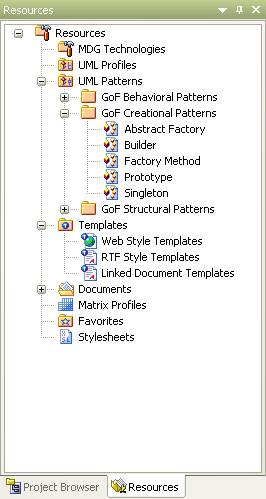The Resources window displays a tree of Model Elements, Scripts, Documents, UML Profiles and Patterns, and Matrix profiles. This view provides useful shortcuts and re-use functions that you can use to add stock elements to the current model, patterns and elements for additional information.

| · | , and provide a convenient way to insert complex new elements and features without having to retype or reconfigure each element |
| · | provides templates you can design yourself to apply to your documentation in either RTF style or Web style, to customize the RTF and HTML that make up Enterprise Architect reports |
| · | provides a shortcut to the RTF and HTML documentation functions |
Tip: To add a document to the shortcut list, select the menu option. Once you have defined your document click on the button and type in a name. The document name then displays in the Resources window. By right-clicking on the document name you can regenerate documents, or open them directly from Enterprise Architect.
| · | provides quick access to saved Relationship Matrix profiles; double-click on a profile to load the matrix with the saved settings and source-target packages |
| · | provides a shortcut to elements that you configure as a shortcut |
| · | enables you to import XSL Style sheets, which are then available in the drop-down list on the XML Export dialog. |
Note: If you select a style sheet on export, Enterprise Architect applies that style sheet to the XMI generated before saving to file. This makes it convenient to generate other forms of output from the base XMI content. Combined with UML Profiles, this is a powerful means of extending Enterprise Architect to generate almost any content required.



